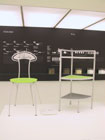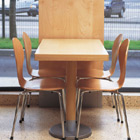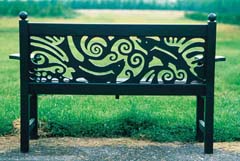Furniture
10. Chairs, upholstery frames and benches



A. Chairs
The availability of MDF in a wide range of sheet sizes and thicknesses allows economical cutting of the components required for the manufacture of chairs for different uses. Standard grade MDF can be used satisfactorily for chairs which are largely based on panel designs providing appropriate panel jointing systems are selected to support the sustained and intermittent shock loads expected in normal use and occasional misuse.
The design of open structure chairs is more critical as the loading stresses will be concentrated in a small volume of MDF surrounding the leg/rail joints. When working with relatively large cross section components compared with the solid wood equivalents, standard grade MDF can be considered but the use of high density MDF with its higher bending strength and greater resistance to repeated impact loading is recommended. Solid wood dowel or loose tongue joint reinforcements are recommended in preference to tenon joints between MDF components.
Having regard for the possibility of personal injury resulting from the failure of a chair in service, testing of a prototype chair of novel design manufactured from MDF or indeed any other material against national or, where available, international standards is strongly recommended.
Once the satisfactory performance characteristics of the prototype have been established, efforts can be directed towards design improvements involving rounding the corners and bullnosing the edges. A localised reduction in cross section may be acceptable as a design feature provided an adequate strength is achieved from the cross section at each joint. The chairs can be finished by painting or with stain and clear lacquer to bring out the surface characteristics of the MDF.
B. Laminated bends for seats and backs
Curved seats, backs and arm rests used in the manufacture of contract and institutional chairs can be produced by laminating thin MDF, available in thicknesses down to 1.8 mm, to build up the required thickness to be determined by the size of the panel and the support arrangements. Laminated boards in the thickness range 12 to 18 mm are considered to be appropriate for these applications.
Show wood panels can be embossed with a shallow texture and then stained and lacquered. Alternatively the laminated MDF seats and backs can be upholstered.
C. Upholstery frames
High strength, good screw and staple holding and easily machinable shapes are desirable characteristics for any material used for the construction of upholstered chair frames.
MDF has these characteristics. Standard grade MDF can be used for all the low load bearing elements, backs, side panels, wings and arm rests for instance. High density MDF should be used for structural rails and other high load bearing elements.
Frames can be manufactured wholly from MDF panels and rails but most manufacturers will optimise the design and manufacturing costs by using MDF for the low load bearing panels in conjunction with hardwood structural rails.
D. Benches and Pews
MDF can be used effectively for the construction of benches and church pews without the high wastage factor and the distortion problems associated with kiln drying large section solid wood planks. End panels and cross rails can be cut from a single sheet of MDF eliminating the need for edge jointing small section wood pieces. A real wood look can be achieved by surfacing both faces of these panels with oak or other appropriate veneer. Slab seats can be cut from MDF, now available in thicknesses up to 60 mm, and machined down to the required profile. Alternatively, the profile can be built up by laminating MDF strips to an MDF base panel. Straight seats can be wood veneered in a membrane press, veneering curved seats would be more difficult.
Apart from standardised benches for institutional use, MDF panels can be used to manufacture feature seating. In an example of a reception area bench, the tripod legs were manufactured by edge jointing three shaped leg sections. The seat has been cut from a 50 mm thickness board.












